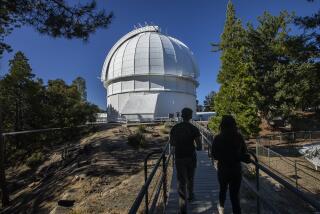Robert Wilson; Physicist Designed Fermi Accelerator
- Share via
Robert Rathbun Wilson, a nuclear physicist active in the Manhattan Project who later designed and directed the Fermi National Accelerator Laboratory (Fermilab) near Chicago, has died. He was 85.
Wilson, a UC Berkeley-trained nuclear physicist who had taught for much of his career at Cornell University, died Sunday in Ithaca, N.Y., of complications from a stroke he suffered last year.
A wunderkind who helped Enrico Fermi and others develop the atomic bomb and later had a distinguished teaching career, Wilson probably will go down in history as not only the expert on particle accelerators, but also as the man who built Fermilab cheaply and aesthetically.
The laboratory has been the world’s largest since it began operation in 1972 and will remain so until 2006, when it will be overshadowed by a particle accelerator now under construction in Geneva.
Wilson was director of Cornell’s Laboratory of Nuclear Study when he was called to Batavia, Ill., in 1967 to build and run the four-mile-long facility. He stayed until 1978.
In an anecdote reported in the industry publication Engineering News-Record, physicists at Berkeley had proposed to build an atom smasher that would boost the energy of speeding protons to 200 billion electron volts before colliding them--estimating the cost in the early 1960s at $350 million. The Atomic Energy Commission approved the project but limited the budget to $240 million. But the team at Berkeley, home of particle physics in the United States, turned down the directorship, contending that the lab could not be built for so little money.
Wilson took the job and built an atom smasher capable of accelerating protons to 400 billion electron volts--twice Berkeley’s proposed speed--for $235 million.
He even made it attractive. Fermilab’s striking architecture was set amid hundreds of acres of land accented by abstract sculpture, fish ponds and even a herd of bison.
A sculptor in his off-duty hours, Wilson demanded aesthetics in his workplace. So, in assembling his team for the new lab, architects and artists were at the top of his list to design the buildings, the accelerator itself and tools to assist the scientists.
Wilson, far from the dispassionate scientist one might expect, once described in a treatise what scientists have in common with artists:
“They both care deeply about what it is they do, and they tend to be single-minded in going about doing it. They both usually pass through a morose period when their contemplation is deep, and mostly at a subconscious level. Finally, what they do create just comes bubbling up from the subconscious to the conscious mind. Inevitably, this inspirational act is accompanied by a period of euphoria, an ecstasy which has been documented time and again for scientist and artist alike.”
Wilson experienced that euphoria in his youth, walking home one night from Los Alamos, N.M., when, at the age of 25, he suddenly visualized how to construct the atom bomb.
“My mind was going a mile a minute,” he told Philip J. Hilts for his 1982 book “Scientific Temperaments: Three Lives in Contemporary Science.”
“I was thinking of all kinds of things at once. I thought, my God, I am the man who knows how to make the bomb!” Wilson said. “I had all sorts of other fantasies as I was walking; I imagined women throwing themselves at my feet, I imagined myself making a fortune, even imagined myself becoming president.”
What he never imagined, he said, was that some years later his 11-year-old son would come home from school, angry and distraught, and say: “How could you do it, Pop? How could you?”
The first atomic bomb Wilson helped create, which was dropped over Hiroshima, Japan, killed 140,000 people. A second bomb dropped on Nagasaki killed 70,000 people. The bombings ended World War II, but began a controversy over use of nuclear power.
Born in Frontier, Wyo., Wilson taught, in addition to Cornell, at the University of Chicago, Columbia and Princeton universities.
He is survived by his wife, Jane; three sons, Daniel, Jonathan and Rand; a sister, Mary Jane Greenhill of Palos Verdes Estates; and four grandchildren.






